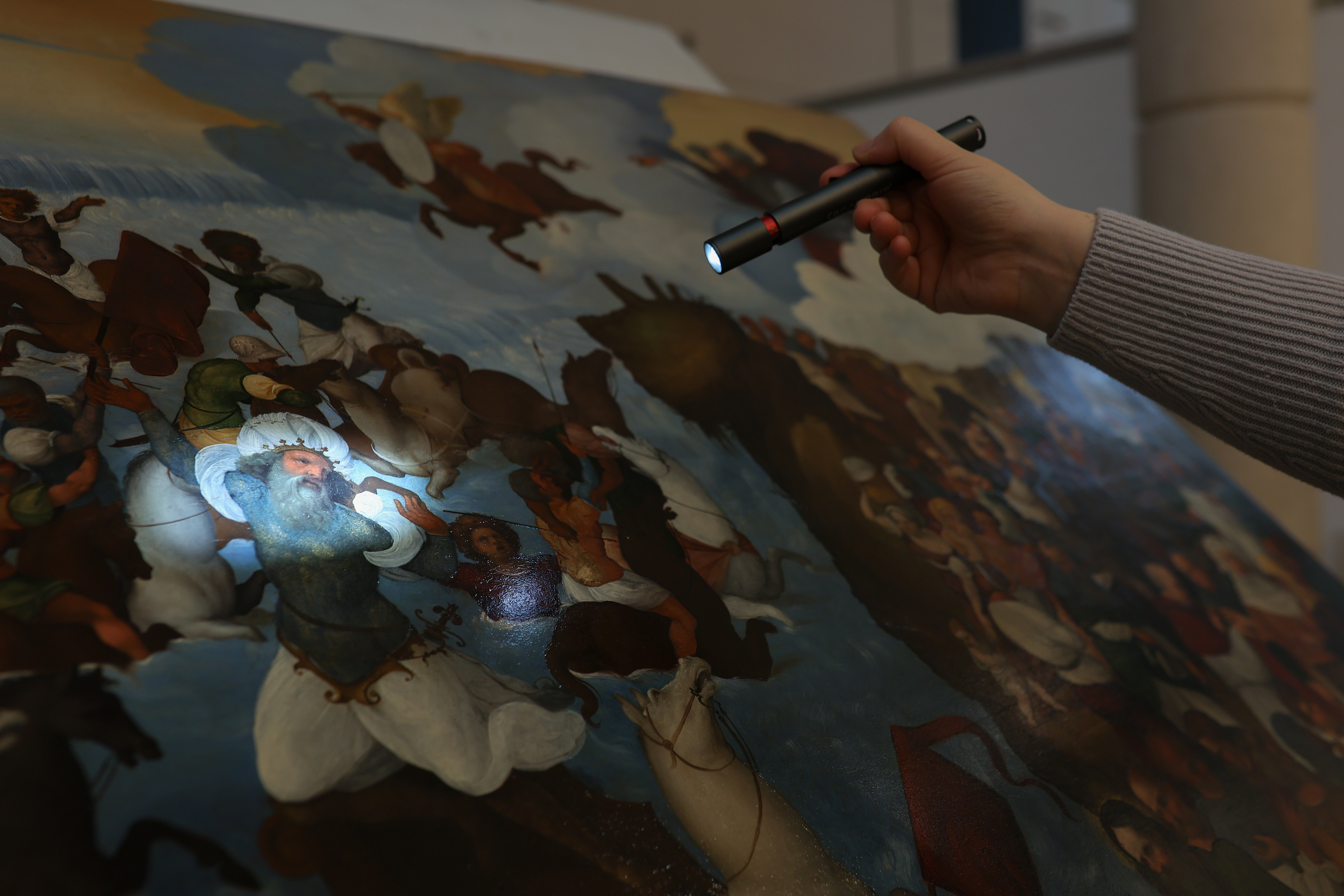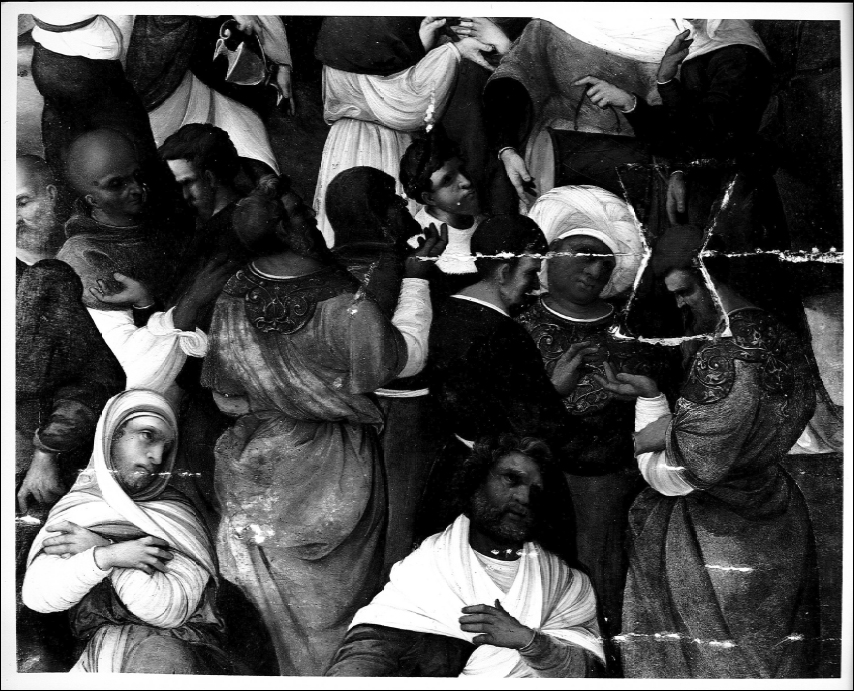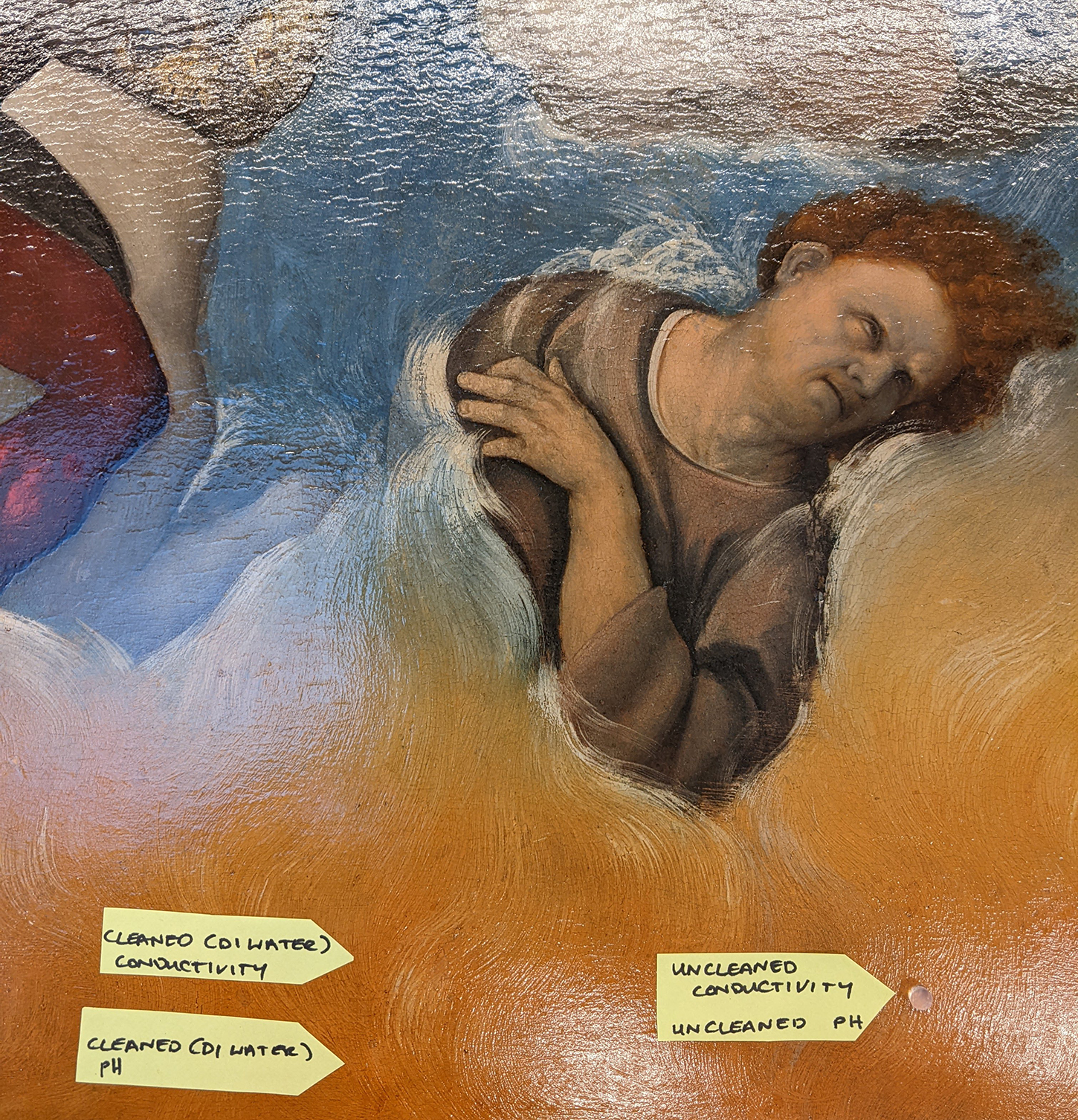 Photo by Molly Keane
Photo by Molly Keane

Discover the science and artistry behind the preservation of this Renaissance masterpiece.
The Crossing of the Red Sea (1521), by Italian Renaissance artist Ludovico Mazzolino (c.1480–1528) has been the subject of an in-depth conservation and research project at the National Gallery of Ireland, with the support of the TEFAF Museum Restoration Fund. This project has been a collaboration between conservators, scientists and curators at the Gallery.
An exhibition celebrating the display of this newly conserved painting can be found in the Sir Hugh Lane Room here at the Gallery from 15 February to 6 July 2025, admission free. Find out more about the exhibition here.
 Photo by Molly Keane
Photo by Molly Keane
The Conservation Process
Key Steps
- Condition Assessment
- Scientific Analysis
- Treatment Plan
- Future Preservation
1. Condition Assessment - understanding the painting's physical state.
This significant work by Mazzolino has been out of public view in recent years due to concerns for its stability. Documentation dating back as far as the 1930s noted fragility and risk of paint loss and the painting was comprehensively treated at the National Gallery of Ireland's conservation department in the 1970s to secure the loose and flaking paint. Photographs from that treatment, like the one below, illustrate the extent of damage to the paint layers.
 An archival photo of a detail from Mazzolino's The Crossing of the Red Sea.
An archival photo of a detail from Mazzolino's The Crossing of the Red Sea.
The initial steps in the conservation process were to establish the factors causing the instability and deterioration of the painting, and to evaluate solutions that might prevent further deterioration of this treasured panel. A comprehensive suite of technical imaging and scientific analysis guided this process, and discreet tests were carried out on the surface of the panel to establish the sensitivity and behaviour of the materials present. The structure and materials of the painting were investigated microscopically and the team researched other paintings by Mazzolino.


2. Scientific Analysis - advanced techniques used at the Gallery’s new scientific facility to uncover material composition.
The slideover images below shows a UV image of the painting (top) and an infrared image (bottom).




3. Treatment Plan – restoring and preserving fragile paint layers.
After careful testing, the team put the treatment plan into action: removing years of dirt, grime and grease from the paint surface, reducing 20th century varnishes and old restoration products, and gently encouraging the paint to re-adhere to the panel support with the aid of mild heat and natural adhesives.
 Example of a cleaning test on Mazzolino's The Crossing of the Red Sea using agarose gel
Example of a cleaning test on Mazzolino's The Crossing of the Red Sea using agarose gel
4. Future Preservation – maintaining long-term stability with innovative solutions.
The moisture content in the air around us can have a dramatic effect on wooden artworks. Wood is a hygroscopic material, meaning that it absorbs water from the air, expanding and contracting as the moisture content increases and decreases. Mazzolino’s panel is particularly susceptible to these movements, which can lead to cracked, loose and flaking paint on the panel surface. To reduce these risks, a special enclosure, known as a microclimate, was fitted to the frame. This enclosure creates a sealed oxygen barrier around the painting, preventing changes in moisture levels within the package.


Scientific techniques used
- Portable XRF and digital microscopy
- Infrared Imaging
- FTIR Spectroscopy
- Raman Microscopy
- SEM-EDS
Insights and Discoveries
Hidden sketches
A number of hidden sketches were revealed beneath paint layers - use the sliders below to take a closer look.




Use of pigments
This research and conservation project gave us excellent insight into Mazzolino's use of rare pigments like gold, silver, and lapis lazuli, and his use of blues like Ultramarine and Azurite.
Scientific analysis found that Mazzolino used both the expensive Ultramarine and the more affordable Azurite for blue passages in the painting. Despite its relative cost - often more than ten times that of Azurite in this period - Mazzolino chose to rely on Ultramarine as the predominant colour in the panel, using it to colour the sea and sky, covering the majority of the painting's surface area.
- Lapis lazuli: a rare metamorphic rock containing the mineral lazurite, from which the pigment ultramarine is extracted.
- Shell gold: a fine gold paint made by grinding pure gold leaf to a powder and mixing it with a natural proteinaceous binder.
- Cinnabar: a mercury sulphide mineral from which the red pigment vermilion is produced.
- Azurite: a basic copper carbonate mineral used to produce a more affordable blue pigment.


Behind the Scenes
This short film takes you behind the scenes of this collaborative project, with curator Dr Aoife Brady, conservator Maria Canavan, and scientist Dr Natalia Macro.
Film by The Pimlico Project.

Related content
-

Ludovico Mazzolino: The Crossing of the Red Sea
15 February - 6 July 2025
-

Curator's Introductory Talk: Mainie Jellett and Evie Hone. The Art of Friendship
Join the exhibition curator to learn more about this new exhibiti
-

Talk and Tea: The Conservation of Mazzolino’s ‘The Crossing of the Red Sea’
Join us for a discussion with conservators Maria Canavan and Nata
-

Special Talk: Mazzolino and Renaissance Ferrara
A special talk with Professor David Ekserdjian (Emeritus Professo
